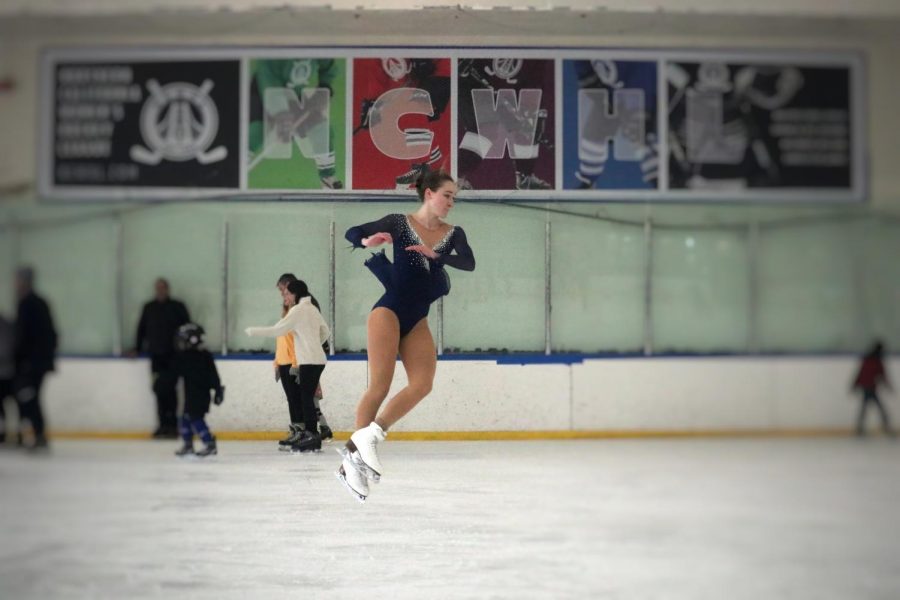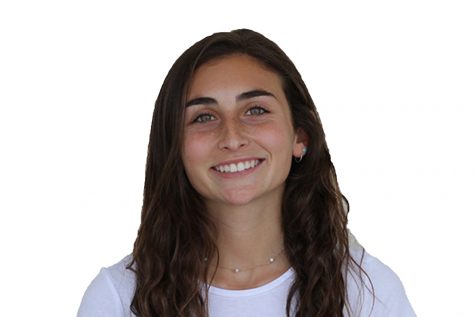For many, ice skating is a one-season sport: a festive winter activity that friends and family enjoy during the holiday season. However, for Joelle Faybishenko, ice skating involves more than just renting skates for $20 and skating around for an hour.
Faybishenko, a senior at Carlmont, has been figure skating since she was seven years old, which requires year-round dedication as well as 16 to 18 hours on ice weekly.
“I wake up around 6 a.m. and go to Fremont. I skate for at least an hour and I have a lesson. Then, I jump in the car, take off my skates in the car, change in the car, and go to school,” Faybishenko said. “After school, I run to the car again, so I can make the public session in San Mateo and skate for another hour. After, I, of course, go home and do my homework.”
To simultaneously keep up with the strenuous demands of figure skating and school, Faybishenko has learned how to balance both important aspects of her life; she often finds herself catching up on homework in the car and staying up late to meet school deadlines.
“I think that in some way figure skating keeps me focused. School is really difficult in that it can get stressful on one hand, and skating can get stressful on the opposite end, so somehow, they manage to cancel out, and my brain can transfer focuses,” Faybishenko said. “I’ve made it work.”
In addition to her academic calendar and 16 hours on the ice every week, Faybishenko is also required to meet the physical education (P.E.) standard of two years to graduate high school, which many have excused by participating in a school sport. In previous years, the Sequoia Union High School District (SUHSD) has excused students with high demanding sports from P.E. requirements.
“Way back when — six or seven years ago — there used to be P.E. substitution. If a student did an extracurricular sport requiring many hours of practice and time, the student could apply for P.E. substitution in their sophomore or junior year of high school,” said Patrick Smith, Carlmont’s athletic director. “This would only work for the second year of P.E. because everyone is required to take the first year. The school board got rid of P.E. substitution because of P.E.’s set curriculum.”
Faybishenko has adapted to this requirement and takes online P.E. through community college because fitting an additional period or high school sport is not feasible with her schedule. Instead, she has used the P.E. requirement to her benefit and counts her off-the-ice training for credit.
On the ice, Faybishenko has perfected all of her single and double rotation jumps. She is beginning to land some of her triples, as the double axel is the gateway to the triple rotation jumps.
Faybishenko’s coach, Ryan Berning, said, “We were able to solidify Joelle’s technique pretty quickly and get her to land a few triples and a consistent double axel.”
According to Olympic coach Michelle Leigh, a skater begins the double axel by turning backward on the take-off foot, tucking the free foot behind, and landing on the free foot. Landing various jumps and turns allows Faybishenko to compete at a higher level and excel in solo competitions.
Another vital aspect of preparation for competitions is the music choice and dress design. Typically, Faybishenko’s mother designs her dress depending on the style and mood of her music and skating routine.
“Everyone does it a little bit differently. I either have my mom make the dress or I go to a dressmaker. If it’s a gentle, pretty, elegant song, you’ll probably go with a lighter color, or if it’s more aggressive or electrical, the dress might be black or silver, and the lines will be more jagged,” Faybishenko said. “In the end, it still needs to be a performance dress: aerodynamic, comfortable, and tight.”
In addition to challenging her individual performance skills and competing in about four local competitions yearly, Faybishenko recently joined a Theatre on Ice (TOI) team.
“Theatre on Ice is a form of competitive figure skating that is popular in Europe, where it is known as Ballet on Ice,” according to U.S. Figure Skating.
Faybishenko’s TOI team competed in the Nation’s Cup in April of 2019, an international competition, in France. In addition to winning two silver medals and a bronze medal, they are also national champions.
Ultimately, TOI has opened Faybishenko’s eyes to other possibilities within the figure skating world.
“Growing up as a solo skater, I was in the mindset that this is an independent sport, it’s just me, and team sports are lame. But, Theatre on Ice has shown me that it’s cool to be skating along with other people,” Faybishenko said, “You can tell a story to an extent as a single skater, but with a team, you really can express a story and take a piece of music and turn it into something.”
While Faybishenko enjoys both solo skating and TOI, she prefers solo skating as it allows for personal freedom and requires a higher level of technical elements. Throughout Faybishenko’s 10 years of skating, she has cultivated an identity based upon her life on ice.
“Skating has been a separate world that I can step into, a world where it’s trying and difficult, but it’s filled with unique opportunities, people, and experiences that have repeatedly taught, shaped, and led me throughout my life,” Faybishenko said.

































